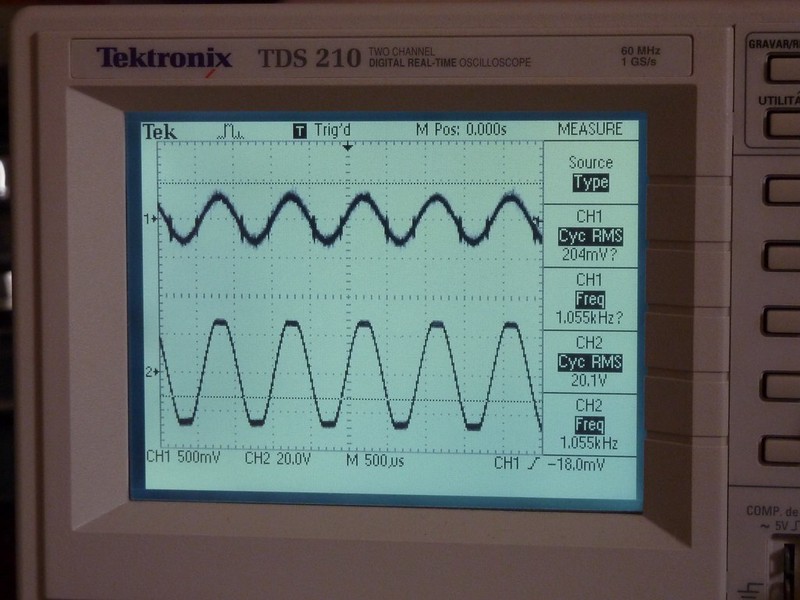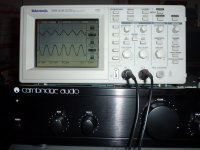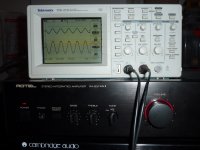Mortymore - nice looking test rig and thanks for posting! Your results are interesting.
A few questions:
I would say from your measurements of the amps, the Rotel has just enough headroom at 11:00 The Cambridge may be clipping at the same SPL.
A few questions:
How did you arrive at that number, and what does the 5V relate to? Do you mean that's the level of a -12dB full scale (-9db RMS) test signal at your loudest level? That seems to be confirmed by your later tests.I would say that I'll need with each of this amplifiers, something around 5v at the output to have good listening level in the room (4.5m * 7m) were I use them.
How did you determine maximum? Did you look for clipping on the scope, or some other method?(approximated values)
Max voltage input: 170mv
Max voltage output: 18v
Max current output: 2.2A
Max power calculated from measurements: 40W
I would say from your measurements of the amps, the Rotel has just enough headroom at 11:00 The Cambridge may be clipping at the same SPL.
How did you determine maximum? Did you look for clipping on the scope, or some other method?
I would say from your measurements of the amps, the Rotel has just enough headroom at 11:00 The Cambridge may be clipping at the same SPL.
The method to find the maximum power was what you described.
Volume knob full turned, raising input signal until at the output of the amp the oscilloscope shows the signal clipped.
I only have a photo for Rotel RA-931, of the signal clipped (ch.2)

The Cambridge Audio A1 v3.0 is less powerful and I can set the volume, lets say up to 2 o'clock.
I didn't done a thorough test for CA1 as for RA-931, but when I got the chance, I can do the proposed test with the CA1, and take a photo of the signal clipped.
One note: This is a system that I have in my attic, and ceiling is leaned, so there's less room volume as could be expected from a regular room.
Cumps
I have 3 amplifiers. The previous mentioned Rotel Ra-931, Cambridge Audio A1 v3.0 and in my living room I have an Audiolab 8000A. I haven't done any measurements on this last one, but thoug the volume of the room his higher, I can't turn the volume of the amp much above 10 o'clock, maximum 11 o'clock with low level recordings. This is partially due to the speakers, Tannoy Mercury V4, that with bass reflex output to the rear, fill the room with sound very easily, and of course, Audiolab 8000A can deliver more power than my other 2 amps.
If I got the time, I can test this too, though it might take some time until that happens.
Regards
If I got the time, I can test this too, though it might take some time until that happens.
Regards
Once you know the volume rotation for that amplifier and speaker combination, this "test" alleges that it can predict the maximum power your system needs to never clip again.
Just pop the CD in, play and measure the amplifier output voltage without changing the volume rotation you found earlier.
Just pop the CD in, play and measure the amplifier output voltage without changing the volume rotation you found earlier.
Tests done running the 220Hz audio track from a CD player, and turning volume up until the output signal clips. 8 Ohm dummy load used.
Tests done with:
Cambridge Audio A1 v3.0
- Volume up to between 3 and 4 o'clock
- Output signal clipped slightly above 15v
Rotel RA-931 MKII
- Volume up to between 2 and 3 o'clock
- Output signal clipped slightly above 19v
Since the input signal provided by the audio track recorded is around 350mV RMS, and that exceeds the maximum input voltage supported by each amplifier to attain the maximum volume without distortion (200mV and 170mV), surely that they had to clip somewhere before that.
Guess that this was the intend test on the first place. Or am I still missing something?
Pictures attached are from fresh made tests reported here.
Regards
Tests done with:
Cambridge Audio A1 v3.0
- Volume up to between 3 and 4 o'clock
- Output signal clipped slightly above 15v
Rotel RA-931 MKII
- Volume up to between 2 and 3 o'clock
- Output signal clipped slightly above 19v
Since the input signal provided by the audio track recorded is around 350mV RMS, and that exceeds the maximum input voltage supported by each amplifier to attain the maximum volume without distortion (200mV and 170mV), surely that they had to clip somewhere before that.
Guess that this was the intend test on the first place. Or am I still missing something?

Pictures attached are from fresh made tests reported here.
Regards
Attachments
Once you know the volume rotation for that amplifier and speaker combination, this "test" alleges that it can predict the maximum power your system needs to never clip again.
Just pop the CD in, play and measure the amplifier output voltage without changing the volume rotation you found earlier.
In essence yes, but one can look at this in a different way if they want.
1) Take a CD, encode a signal recorded at 0dBfs onto it.
2) Play this CD back on your system.
3) Measure the voltage on the output of your amplifier with an oscilloscope whilst you are doing this.
4) Increase the volume on your amplifier until you see clipping.
5) Turn it down a little so it stops clipping.
6) Note the position of the volume control.
Now if your amplifier is never going to go into current limiting because it's more than capable of driving your loudspeakers (which it should be), then you know, that if all you listen to is CDs, that you will never clip your amplifier if you keep the volume control at the position you determined during step 5.
This test is really just another way of doing something like that, but does it instead by you setting the volume first at the loudest you'd ever listen. It is then calibrated by a known quantity, the test tone and measured using your volt meter.
The test tone is set at a level that will not clip the amplifier as it is quite low in level. Once you've measured the voltage that the test tone produces on the output of your amplifier you can then calculate what the voltage level required would be to actually reproduce the level you were listening at. Then you can determine if your amplifier is actually clipping, nor not.
Quite correct 
I did not want to provide a full scale signal for the test out of respect for your ears, speakers and amps. Bringing the test tones down 9dB RMS from max leaves them strong enough to easily measure - without risk.
Because the levels on a digital recording have an easily determined maximum, that makes this test an easy one. Remember - think "From the top downward" on this test

I did not want to provide a full scale signal for the test out of respect for your ears, speakers and amps. Bringing the test tones down 9dB RMS from max leaves them strong enough to easily measure - without risk.
Because the levels on a digital recording have an easily determined maximum, that makes this test an easy one. Remember - think "From the top downward" on this test
Maybe. Not sure.Guess that this was the intend test on the first place. Or am I still missing something?
The test tones I provided havd a peak value of -9dB from full scale. If the amp is clipping that, then it will be clipping the hell out of full scale peaks. No doubt.
If you want to determine at what volume setting your amps clip from a full scale signal then you should use a full scale signal. But most people here dont have a scope and dummy load, so cant test directly as you can. The test here lets you know what voltages to expect from yor amp at a given volume setting.
Running my test my not actually tell you if your amp is clipping when you run it loud, but should give a pretty good idea of how much headroom there is.
I run at -40 dB on my pre, most of the time, meaning I'm stuck in the first few steps of the volume rotation- the price to pay for having >300WPC on tap and 100+dB speakers. Moderately loud is measured in .2-.3 volts average, here.
IMO that is an inefficient, possibly? poor setup.
I had similar and resorted to padding the Pre's Attenuators with a 1 ! meg Resistor.
IMO it sounds better for it.
But clearly my Pre needs reconsidering if not discarding, as it's an inappropriate match to both Amp and Drivers.
IMO that is an inefficient, possibly? poor setup.
I had similar and resorted to padding the Pre's Attenuators with a 1 ! meg Resistor.
IMO it sounds better for it.
But clearly my Pre needs reconsidering if not discarding, as it's an inappropriate match to both Amp and Drivers.
On my digital front end I have more resolution and downward range if needed, via digital volume control. On analog, I have to "set it and forget it", which is okay, because I'm not terribly picky about having high volume resolution- 3dB steps or so are okay, and the lowest setting is as low as I need to go.
A lower powered amp would be a better match to the VC ranging, which is a S&B TX-102 based transformer volume control setup, but I like my big UCD amp which allows me to use it for any speakers I want, it's not picky.
But there have been times where I've added resistor networks to amp and preamp outs and ins, when needed- if noise is an issue, upping the gain and using resistors is often the best solution, but my current setup is extremely quiet despite high sensitivity amp and speakers.
Hi Pano,
Did the test today, measured 1.8 V on speaker terminals.
Setup : Najda DSP was fed by a Roomplayer by SPDIF, level was set at -13db on the DSP. Output was connected to Poppulse T150 amp (TA2022 chip). Speakers are Nomex 164. nominal impedance 8 ohms, sensitivity around 90dB SPL/2.8V @ 1 meter.
The max power used at loud listening should be ((1.8x4)(1.8x4)/8 ~ 6.5 Watts
I'm right ?
Did the test today, measured 1.8 V on speaker terminals.
Setup : Najda DSP was fed by a Roomplayer by SPDIF, level was set at -13db on the DSP. Output was connected to Poppulse T150 amp (TA2022 chip). Speakers are Nomex 164. nominal impedance 8 ohms, sensitivity around 90dB SPL/2.8V @ 1 meter.
The max power used at loud listening should be ((1.8x4)(1.8x4)/8 ~ 6.5 Watts
I'm right ?
Which post shows how to get from the measured single test tone voltage to the maximum power of the amplifier.
I looked at the first two and it's not there.
Post 104
post 104 thanks.
Pano could you link post 104 to first post so that all can find and read.
Pano could you link post 104 to first post so that all can find and read.
Let's look at that with example numbers:
Your measured voltage is 5 volts.
.........................
Or... 5x5=25 (watts) Voila!
Pascal,
Pano designed the test procedure and the test levels to make the arithmetic easy.
and to ensure the stages were not overloaded during the test.
But there in lies the problem that I have argued against unsuccessfully.
It does not guarantee not overloading and that results in false conclusions.
I still believe the test is flawed but no one believes me.
However it's better than any other simple test that I have seen or that I could devise.
In that respect it is very useful.
Now your result: 1.8Vac
1.8 squared is 3.24
A 4W amplifier will always meet your loudest listening needs and never be overloaded.
Wrong!
Pano designed the test procedure and the test levels to make the arithmetic easy.
and to ensure the stages were not overloaded during the test.
But there in lies the problem that I have argued against unsuccessfully.
It does not guarantee not overloading and that results in false conclusions.
I still believe the test is flawed but no one believes me.
However it's better than any other simple test that I have seen or that I could devise.
In that respect it is very useful.
Now your result: 1.8Vac
1.8 squared is 3.24
A 4W amplifier will always meet your loudest listening needs and never be overloaded.
Wrong!
Last edited:
Apparently you missed me and Tom Danley taking exception. I'll trust it when the prosound engineers adopt it to design/test live events. Till then, I'm sticking with the proven math since worst case is having too much dynamic headroom for the app, which to me is like having more food, selection at a buffet than necessary. 
GM
GM
- Home
- Loudspeakers
- Multi-Way
- A Test. How much Voltage (power) do your speakers need?

